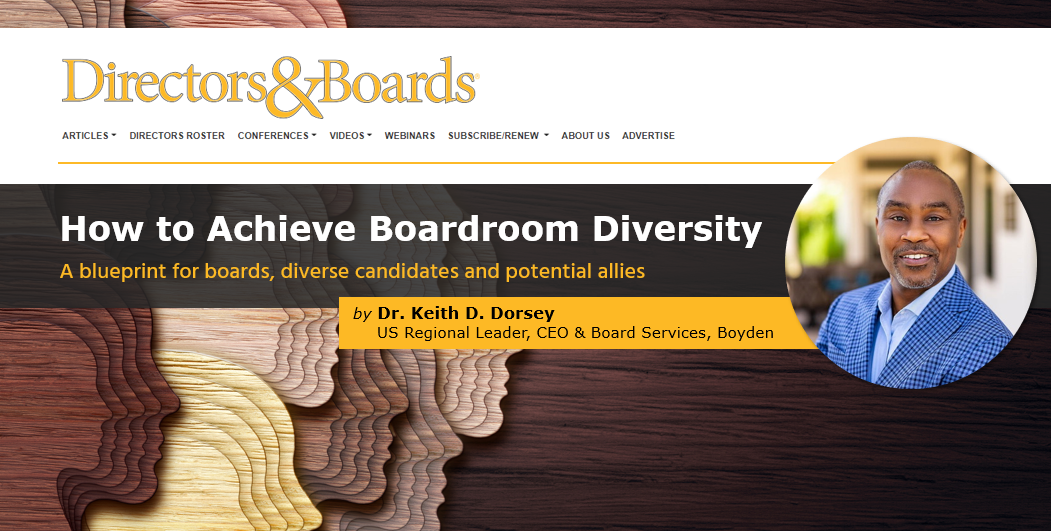This article was originally published by Directors & Boards magazine - please click here to view.

A blueprint for boards, diverse candidates and potential allies
The need for board member diversity — specifically, increasing the representation of women and ethnic minorities — has become a frequent topic inside and outside the boardroom. Despite this increased attention, women and people of color remain significantly underrepresented in corporate boardrooms. Understanding and addressing this issue is best achieved by considering three crucial perspectives surrounding the placement of directors: that of nom/gov committee members, that of the diverse candidates themselves and that of the potential allies who could aid in matchmaking diverse candidates with the boards that need them. Based on conversations with corporate directors, here are some practical steps each of these parties can take to help increase diversity in boardrooms.
Current Approaches and Challenges to Improving Boardroom Diversity
Despite the benefits and need for diversity in the boardroom, most boards are made up of current and former CEOs and CFOs, meaning board members generally are near or at retirement age, white and male. Herein lies a troubling disparity: Although white men make up 30% of the U.S. population, their representation on Fortune 500 boards is a whopping 61.7%. This is but one visible example of the low diversity present on many boards. Three main approaches have been taken to help improve board diversity and, with it, the quality of oversight, management and advisory services the board provides.
First, boards have sought to achieve a balance of internal and external directors to take advantage of insider insights while leveraging the fresh perspectives and expertise outsiders can bring. Internal board members commonly include the firm’s current CEO and CFO, while independent directors are often active or retired CEOs and CFOs from other companies. Stock exchange listing standards require public companies to have independent directors and, as of 2021, 86% of S&P 500 firms’ board members were independent.
Second, a push for gender diversity has been championed by organizations like Women Corporate Directors, 50/50 Women on Boards and Thirty Percent Coalition. Although this decades-long effort has resulted in more women on boards, limited traction has been gained by other underrepresented groups. For example, recent statistics indicate that white women hold 20.85% of Fortune 500 board seats, while ethnic minority women occupy a mere 5.66% of these seats.
Third, legislation has helped to diversify boards. Several European countries have mandated that publicly traded companies meet gender quotas in their boardrooms, and dramatic gains in female representation have been achieved. Recent statistics reveal that women now hold roughly two-fifths of public board seats in Norway (on boards of at least four members), almost half the public board seats in France and roughly two-thirds of public board seats in Spain. However, in the U.S., no federal mandates and few state mandates exist to require board member diversity. California’s Senate Bill 826, introduced in 2018 when less than one-sixth of California board seats were occupied by women, had the effect by 2021 of more than doubling women’s representation so that they held nearly one-third of California public corporation board seats.
While more research is being conducted and policies are being proposed to improve matters, those closest to the situation (i.e., nom/gov committee members, diverse candidates, their allies) need not wait to take action to improve director diversity.
Blueprints for Achieving Diversity
An Ancient East Indian parable tells of a group of blind men encountering an elephant. Because each man touched a different part of the elephant, each had a different idea of what it was, and none had a complete picture of the animal’s shape. Trying to address diversity in the boardroom can feel like trying to describe an elephant based solely on touching the tail. Depending on your perspective, the challenge may seem like a lack of qualified candidates, a lack of access to opportunity or a lack of engagement from those you are trying to help. As in the parable of the blind men and the elephant, each perspective is valid, albeit subjective and incomplete. We need to resist assuming that our perspective is absolutely true while the perspectives of others are off base. This very human tendency is referred to as the Rashomon effect, where the parties and observers of a shared situation have contradictory accounts that reflect their subjective interpretations and self-interests rather than an objective truth.
Nom/gov committee members, diverse candidates and the allies of potential board candidates all are parties to the complex task of increasing boardroom diversity. Making lasting change is difficult; however, a critical starting point is understanding and expanding these perspectives while outlining the concrete steps each group can take to create needed change while we await research, policy and institutional structures that inform, enforce and support such changes.
The Nom/Gov Perspective
Nom/gov committee members are no strangers to the need for boardroom diversity. These individuals have been on the frontlines of this issue, receiving pressure from policymakers, institutional investors, shareholders and society at large that their board needs to be more diverse — specifically, by placing women and people of color. The charge has been issued, yet the problem persists. Ask any nom/gov committee why the problem still exists, and the answer is likely to be, “We can’t find them.”
What They Are Doing Now
Historically, corporate boards consist of current and former CEOs and CFOs, and they often reach out to their closed-group networks of other CEOs and CFOs to recruit new board members. In my recent study of diverse board directors, one 23-year veteran of board service explained that boards do this because “directors get nervous when they’re looking at people they don’t know. They want to know how you will play in the sandbox.”
But therein lies the problem: If the board is primarily composed of white men in their 60s, their social networks also tend to consist of white men in their 60s.
The next stop is enlisting the help of a board search firm. However, as a director in my study explained, most recruiters don’t have diverse candidates in their networks either. Worse, when recruiters encounter such candidates, they perceive them as a tough sell. One former consultant and CEO now serving on six boards shared that many executive recruiting firms had told her, “Your background is fantastic. You would be great on this board, but you are an out-of-the-box candidate, and I will really have to convince the board that it is worth it for them to speak with you.”
The good news is that gaining access to the vast pool of qualified diverse candidates is possible — if boards will ask themselves, “What are we prepared to think and do differently to get different results?
What They Really Need to Do
As with most complex problems, insight and change begin with acknowledging that what you’re doing now isn’t working and that the answer you need, no matter how elusive it seems, is available. For nom/gov committees, that begins with recognizing they have a problem finding a qualified pool of diverse executives and directors, followed by adjusting their methods of identifying viable candidates. The directors I spoke with confirmed that boards are beginning to broaden their search for directors beyond the traditional CEO and CFO roles, including looking for other C-suite executives, functional experts (e.g., cybersecurity, technology, human resources, legal, marketing, sales), division presidents, and those with profit and loss operating experience.
As a nom/gov committee member, you can employ three specific tactics for recruiting qualified diverse candidates who will elevate the quality of your board:
- Figure out what your board needs. According to the directors I spoke with, the boards that succeeded in diversifying ranks began with a careful examination of their existing competencies. As one director with 17 years of experience across seven boards explained, “Boards are finding that directors with functional executive experience bring valuable expertise that makes a meaningful difference for the company.” By examining your current directors’ skill sets, knowledge, experiences and networks, you can identify areas of redundancy as well as areas of critical gaps. A careful analysis will yield the qualities and qualifications of the director you need.
- Locate needed candidates. Using the director profile you created, leverage your board members’ networks to identify potential candidates. If you come up short, enlist the help of a search firm. If you continue having difficulty finding suitable candidates, ask the diverse directors you or your contacts know for referrals. If you still have difficulty, list people you know (e.g., past clients, employers or colleagues, university faculty) who may have access to diverse candidates.
- Create measures and timelines for accountability. Within the nom/gov committee, and with any search firms you engage, outline your planned tasks for recruiting qualified diverse candidates, along with who will complete the tasks and when. Regularly monitor task completion and hold the assigned individuals accountable for the results. Only with careful planning and monitoring will you be able to progressively improve your diverse director recruitment efforts.

The Diverse Candidate Perspective
The challenges of ineffective recruiting pathways hit diverse candidates the hardest. Despite years of perfecting their educational credentials, architecting an impressive résumé of progressive leadership roles and developing their skills to add exceptional value as a board member, many still lack access to board seats. Ask any diverse candidate why they are not serving on a board and the answer may be, “Because of the persistent problems of exclusion and lack of equity, boards and recruiters don’t take me seriously.”
What They Are Doing Now
While exclusion and lack of equity indeed exist, “Boards and recruiters don’t take me seriously” may be more of a hypothesis. Nonetheless, that hypothesis is powerful, and many diverse candidates proceed by doubling or tripling down on their qualifications. Studies have found that candidates from underrepresented groups often have exemplary academic credentials and experience, making them more qualified than some of their boardroom peers.
Yet no degree of competence will overcome the diverse candidate’s lack of board-specific exposure or the lack of others’ awareness that the candidate wants to serve. Thus, the cycle continues.
Fortunately, diverse candidates can change their lot if they ask themselves, “If I want to secure a board seat, what am I doing today to position myself for these opportunities?”
What They Really Need to Do
Diverse candidates can do much to improve and expedite their pathway to a board seat. Three particularly powerful tactics aspiring diverse candidates can deploy are:
- Boost your board-related skills, knowledge and experience. Depending upon the size, strategic objectives and needs of the organizations they serve, boards require their directors to have specific competencies and experience. The first step is to assess your unique strengths, weaknesses, knowledge, skills, experiences and interests. As one director I interviewed advised, “The best thing you can do is focus on the current issues in the boardroom and figure out what fits your profile.” Additionally, aspiring directors often have board-specific competency gaps that must be filled to become a serious candidate. Recommended developmental activities include seeking opportunities to interact with their own firms’ internal boards, joining external board-related groups (e.g., Private Directors Association, National Association of Corporate Directors, 50/50 Women on Boards), reading board-related magazines (e.g., Directors & Boards and Private Company Director) and becoming students of corporate governance as a profession.
- Cultivate your board-related network. The directors I interviewed stressed that their networks played a central role in securing their board seats. Often, aspiring directors may know some individuals who serve on boards, but they have not deliberately built strong networks with them. This is a regrettable oversight, as these individuals are vital to securing a seat. As one director noted, “It is the networking. It really is. You probably know people on boards. You need to reach out to them and meet with them.” These relationships can be forged by joining and attending the networking events held by the external board-related groups mentioned above. Key objectives for these relationships include learning from their experience, maintaining positive rapport and subtly demonstrating your interest and ability to add value to a board.
- Showcase your board aspirations. While fortifying your competencies and building your network are necessary conditions for becoming a serious director candidate, by themselves they are not enough. A final necessary condition is showcasing your board aspirations to all those who have any potential connection to the recruiting process — current and former executives, current and former board members, and board search firms, among others. By expressing your interest in securing a board seat, why you want to serve and the types of boards where you would best add value, you dramatically increase your chances of landing a seat. All the directors I interviewed shared their own stories of showcasing their interests. As one director put it, “When you meet with your contacts, tell them you’re interested in serving on a board, because those of us who are on boards often are asked if we know anybody.” Another easy way to share your interests is that when someone asks what you do, you can answer, “I am currently [your current role], and I am transitioning to paying it forward by being a board member in [your specific board interests].”
The Potential Ally Perspective
Potential allies include current and former executives with board experience, current and former board members, coaches, mentors, sponsors and other potential career enablers. The directors I spoke with said such individuals were vital sources of support in situations like making work-related decisions, navigating organizations and new industries, overcoming challenges and preparing for strategic decisions. While these important allies also are aware of the challenges related to increasing boardroom diversity, they aren’t always effective at combating the problem. Ask any potential ally why boards are not diverse, and the answer may be, “I don’t know. The diverse directors who make it to the boardroom get there when they are ready.”
What They Are Doing Now
Many potential allies may not see themselves as critical parts of the solution to poor boardroom diversity. After all, nom/gov committees and board search firms exist for this purpose, don’t they? Moreover, for many allies, the process of architecting one’s career to secure board seats has faded from their consciousness, becoming a tacit know-how that evades description. While they expertly do it themselves, they may not see the need or take the time to explain the steps to the would-be directors. If aspiring directors fail to recognize the importance of capitalizing on the opportunity to assume a P&L role or attend an internal board meeting, they might squander the opportunity. These sorts of disconnects frustrate the ally, damage the relationship and leave the mentee stranded in their state of not knowing. In my own experience and that of the directors I interviewed, it appears that many diverse directors stumble onto the pathway to board service by accident. As one director described, “I had a lot of one-on-one conversations with board members, really got to see their journey and background, and thought to myself, ‘This corporate board service line of work would be a great opportunity.’” While stumbling onto the pathway is, indeed, one way to get there, the lost opportunities — for diverse directors and boards alike — can be staggering. Fortunately, these losses can be reduced or avoided if allies ask themselves, “How am I contributing to the problem of poor boardroom diversity, and what can I do to address it?”
What They Really Need to Do
Because allies stand in the gap between diverse candidates and the boards that need them, these allies can play a pivotal role in solving the diversity problem. Three tactics can help these individuals shift from a potential ally to a proactive ally:
- Identify the candidates. Be intentional about identifying the diverse candidates in your organization whom you will intentionally sponsor. By focusing on high-potential candidates and needed board member competencies (and communicating that to them), you ensure that your focus is on talent rather than any other characteristic. After all, no one wants to be a token. Once chosen, get to know these candidates: What got them to where they are today? Where do they want to go tomorrow? How can you help them get there (if they want your assistance)?
- Design the framework. If you are a potential ally, you likely have a number of achievements under your belt and have secured more than one board seat along the way. For you, navigating the pathway to the boardroom is an unconscious competence. The process of doing this may seem obvious, and having to articulate just how to go about it can be difficult. While it may not be rocket science, it can seem complex, ambiguous and even mysterious to the uninitiated. For these reasons, you will need to design your own framework for guiding your mentees if you want to help them reach the boardroom. Become consciously competent about the process by reflecting on your own experiences, asking others about their experiences and reviewing the tactics in the previous section. These activities will help you outline the tasks and milestones your mentees need to complete along the way. By converting your tacit expertise into concrete knowledge and a pathway, you will become a vital resource for connecting diverse candidates to the fulfilling opportunity of a board seat and, in turn, boosting board and organization effectiveness.
- Connect the dots. If you have served on one or more boards, the case for navigating toward a board seat may be open-and-shut. It may be so apparent to you that the idea of having to explain why your mentee should do this would be enough to make you want to select a different mentee. However, based on my own experience (as well as that of others), I assure you that it is not that obvious for even the most talented potential directors. To your mentee, the opportunity you offer them may seem like just another task or role in the company. As their ally, it is your responsibility to help them understand the importance of the steps you are recommending. Paint the vision and help them connect the dots: Describe where you see them potentially going next and keep in mind that they don’t know what they don’t know. They need a boost to think differently and to think bigger, and guidance from people who have already gone down the path of board service can be particularly influential.
Comfortable Being Uncomfortable
Despite our common problem of poor boardroom diversity, there are many and differing perspectives regarding the cause of the problem and what can and should be done to solve it. The blueprints offered above outline concrete tactics that nom/gov committees, diverse candidates and their allies can pursue to make effective, lasting change. It is important to note that at least some of these tactics will be unfamiliar. In that event, it is important to get comfortable being uncomfortable. In doing so, we will travel the necessary transformative path both individually and collectively to reach the future we desire.




